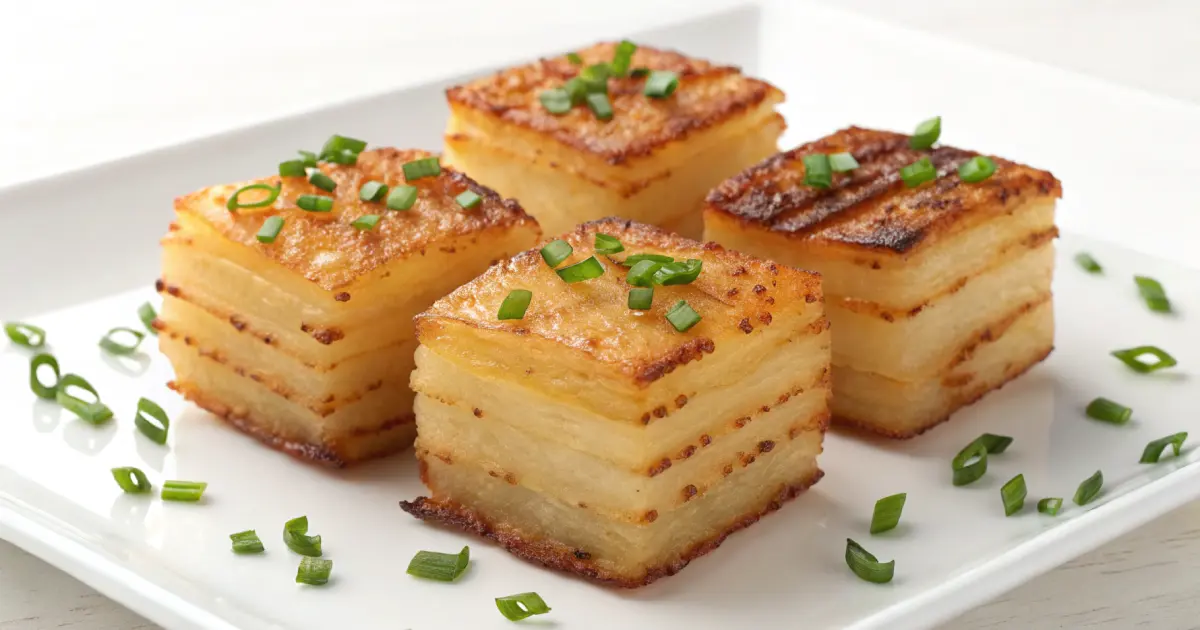Potato Pavé is a delightful French dish that combines simplicity and sophistication in one bite. Known for its strikingly layered appearance and crispy, golden crust, this recipe is a showstopper at any dinner party. From its roots in French culinary tradition to its modern twists, this article explores everything you need to know about potato pavé—how to prepare it, variations to try, tips for success, and the best ways to serve it. Whether you’re a foodie or a casual cook, you’ll find something to savor here.
Introduction to Potato Pavé
What Is Potato Pavé?
Potato Pavé, meaning “pavement” or “slab” in French, is a layered potato dish that looks as good as it tastes. It’s made by thinly slicing potatoes, layering them in a creamy mixture, and baking them to perfection. The result is a terrine-like creation that’s both rich and satisfying. The dish is often topped with a Parmesan crust, adding a touch of crunch to its creamy texture. While traditionally a restaurant favorite, it’s entirely possible to make at home with some patience and the right tools.
History and Culinary Origins of Potato Pavé
Rooted in French cuisine, potato pavé has evolved from a rustic comfort food to a gourmet side dish. It shares its lineage with classics like Pommes Anna and gratin dauphinois, but what sets it apart is its terrine-like structure and versatility. French chefs popularized it for its visual appeal and ability to pair seamlessly with meats, seafood, and even vegetarian dishes. Today, it’s celebrated globally, appearing on menus from high-end bistros to casual dinner tables.
Why Potato Pavé Is Considered a Gourmet Dish
Why all the hype? Simply put, potato pavé is a masterpiece of flavor and presentation. The fine layering creates a mille-feuille effect, while the seared Parmesan crust brings a balance of texture. It’s a versatile dish that can be customized with herbs, cheeses, or even root vegetables. Though it requires effort, its ability to elevate any meal makes it well worth the time. Plus, it’s perfect for making ahead, making it a go-to for elegant gatherings.
Stay tuned as we dive into the art of preparing potato pavé, sharing tips and variations that’ll make it the highlight of your next dinner!
The Recipe and Preparation Process
Essential Ingredients for Potato Pavé
To create a flawless potato pavé, you’ll need just a handful of ingredients, but each one plays a crucial role. The star is Yukon Gold potatoes—preferred for their creamy texture and mild flavor. Other key ingredients include heavy cream, unsalted butter, kosher salt, black pepper, and freshly grated Parmesan cheese. You’ll also need canola oil for searing and parchment paper for lining your pan.
For best results, use fresh, high-quality ingredients. The buttery richness of Yukon Gold potatoes and the nutty tang of Parmesan bring out the best in this dish. Optional additions like fresh thyme, garlic, or even nutmeg can take the flavors up a notch, giving your potato pavé a personalized twist.
Step-by-Step Preparation: Slicing, Layering, and Baking
Creating potato pavé requires precision, but it’s worth every step. Start by peeling your potatoes and slicing them thinly—ideally 1/8 inch—using a mandoline for uniformity. Uniform slices ensure even cooking and give the dish its signature layered appearance.
Next, prepare your creamy base by melting butter and mixing it with heavy cream, salt, and pepper. Dip each potato slice into this mixture, ensuring they’re well coated. Begin layering the slices in a loaf pan lined with buttered parchment paper, overlapping them slightly for a compact terrine. Once layered, fold the parchment over the top and cover tightly with aluminum foil.
Bake the terrine at 350°F for about two hours, then let it cool under weight (such as canned goods) to compress the layers. Refrigerate the terrine overnight to set the shape. This step makes the potato pavé easier to slice and sear later.
Achieving the Perfect Parmesan Crust
The final step is where the magic happens. Once the terrine is chilled and firm, slice it into even squares or rectangles. Dip each piece in freshly grated Parmesan cheese, coating both sides. Heat a skillet with canola oil over medium-high heat, then sear the Parmesan-coated sides until golden and crisp. This step not only enhances the flavor but also adds the dish’s characteristic crunchy exterior.
Serve immediately for the best contrast between the crispy crust and the creamy, tender layers inside.

Variations and Enhancements
Creative Flavors: Cheese, Herbs, and Spices
While the classic potato pavé is divine as is, adding your own spin can make it even more exciting. Swap Parmesan for Gruyère, cheddar, or Pecorino for a different cheesy profile. Herbs like thyme, rosemary, or parsley can be layered between the potatoes for a fragrant twist. Want a little heat? Sprinkle in a pinch of chili flakes or smoked paprika to spice things up.
Vegetarian and Vegan Adaptations
Making potato pavé vegetarian or vegan is easier than you might think. Use plant-based cream and butter substitutes for the creamy mixture, and replace Parmesan with vegan-friendly cheese or nutritional yeast. Layer thin slices of zucchini, sweet potato, or parsnip with your potatoes for added color and variety. The result? A deliciously inclusive dish everyone can enjoy.
Incorporating Root Vegetables and Other Substitutes
Why stop at potatoes? Experiment with root vegetables like celery root, turnips, or carrots. These alternatives not only add vibrant hues but also unique flavors to your potato pavé. Layering a combination of vegetables, such as sweet potatoes and Yukon Golds, creates a striking visual appeal. This approach works especially well when you want to impress at festive gatherings or special occasions.
With these creative tweaks, potato pavé transforms from a simple side dish into a culinary masterpiece tailored to your preferences.
Serving Potato Pavé
How to Slice and Present the Terrine
Presentation is key when it comes to potato pavé. Once the terrine is set and chilled, use a sharp knife to trim the edges and create neat rectangles or squares. For the best results, aim for even, clean cuts that highlight the beautiful layers. Arrange the slices on a serving platter with the crispy Parmesan crust facing up—it’s a visual treat!
Consider garnishing with fresh herbs like thyme or parsley for added color and aroma. To enhance the dish further, drizzle a bit of garlic-infused oil or serve with a dollop of crème fraîche. These small touches elevate the humble potato dish into a gourmet masterpiece.
Pairing Potato Pavé with Main Dishes
Potato pavé is a versatile side that pairs beautifully with a variety of main dishes. It complements roasted meats like lamb or chicken and also shines alongside grilled seafood such as salmon. For a vegetarian option, serve it with a vibrant salad or a hearty vegetable casserole. Its creamy, crispy profile makes it a standout partner for any rich, flavorful main course.
Ideal Occasions for Serving Potato Pavé
Whether it’s a casual dinner or a formal celebration, potato pavé fits right in. It’s perfect for Thanksgiving, Christmas, or any holiday feast where you want to impress. The best part? You can prepare it in advance, making it a stress-free choice for entertaining. For more festive recipe ideas, check out Old-Fashioned Sweet Potato Casserole.
Common Challenges and How to Avoid Them
Preventing Potatoes from Falling Apart
One common issue when making potato pavé is keeping the layers intact. To avoid this, ensure your potatoes are sliced uniformly and pressed firmly while layering. Using a mandoline is crucial for consistent slices. Chilling the terrine overnight also helps the layers set, making it easier to cut and sear without crumbling.
Ensuring a Crispy Crust Every Time
A crisp Parmesan crust is the hallmark of a well-made potato pavé. To achieve this, use finely grated Parmesan and press it firmly onto the terrine slices. Ensure your skillet is hot before adding the potatoes, and avoid overcrowding, which can steam rather than sear. If the cheese isn’t sticking, try adding a light dusting of flour before dipping in the Parmesan.
Troubleshooting Common Mistakes
From uneven cooking to sticking in the pan, small missteps can affect your results. If your potato pavé is unevenly cooked, it may be due to inconsistent layering—take time to align each slice. Sticking can be minimized by using a nonstick skillet and enough oil for frying. Lastly, don’t skip letting the terrine cool before slicing—it’s a game-changer for presentation and texture.
By addressing these challenges, you can master the art of making potato pavé and confidently serve this gourmet delight at your next gathering.
Health and Nutritional Aspects
Caloric Breakdown and Macronutrients
When indulging in potato pavé, it’s worth noting the dish’s nutritional profile. Made primarily of potatoes, cream, butter, and cheese, it is undeniably rich and calorie-dense. A typical serving provides approximately 300 calories, with most of the energy coming from fats and carbohydrates. Yukon Gold potatoes contribute dietary fiber and essential vitamins like vitamin C and B6, while the cream and cheese add protein and calcium.
Adapting the Recipe for Dietary Preferences
For those seeking a lighter version, small adjustments can make a big difference. Replace heavy cream with a low-fat alternative or use a dairy-free cream for a healthier twist. Opt for olive oil instead of butter to reduce saturated fats. Incorporating root vegetables like parsnips or turnips alongside potatoes can further increase fiber content while lowering calories. With these swaps, you can enjoy potato pavé without compromising your health goals.
While this dish is best enjoyed as an occasional treat, these modifications make it accessible to a broader range of dietary preferences.
FAQs About Potato Pavé
Can I Make Potato Pavé Without a Mandoline?
Yes, though a mandoline makes slicing quick and uniform, you can use a sharp knife to achieve similar results. Just ensure that your slices are as even as possible for consistent cooking.
What’s the Best Way to Reheat Potato Pavé?
Reheating potato pavé is simple. Place the slices on a baking sheet and warm them in an oven at 350°F until heated through. Avoid microwaving, as it can soften the crust.
How Do I Store Leftover Potato Pavé?
Wrap leftovers tightly in plastic wrap or store it in an airtight container in the fridge for up to three days. To preserve its texture, avoid freezing, as it can affect the creamy consistency.
Can I Customize Potato Pavé with Other Ingredients?
Absolutely! Adding layers of sweet potatoes, carrots, or even beets creates a colorful twist on the classic. Herbs like thyme or rosemary, or a sprinkle of smoked paprika, can also enhance its flavor.
With these tips, you’re now fully prepared to enjoy and share the magic of potato pavé!
Conclusion: The Appeal of Potato Pavé (100 Words)
Why Every Food Enthusiast Should Try It
Potato pavé is more than just a side dish—it’s an experience. With its creamy center, crispy Parmesan crust, and elegant presentation, it stands out as a true culinary delight. This dish transforms humble potatoes into something extraordinary, showcasing the power of simple ingredients and thoughtful preparation.
A Perfect Combination of Elegance and Comfort
Whether served at a casual family dinner or an upscale gathering, potato pavé strikes a balance between comfort and sophistication. Its versatility, make-ahead convenience, and show-stopping appeal make it a must-try for anyone who loves cooking—or simply loves potatoes!


1 thought on “Potato Pavé Recipe: Crispy Layers of Gourmet Perfection”